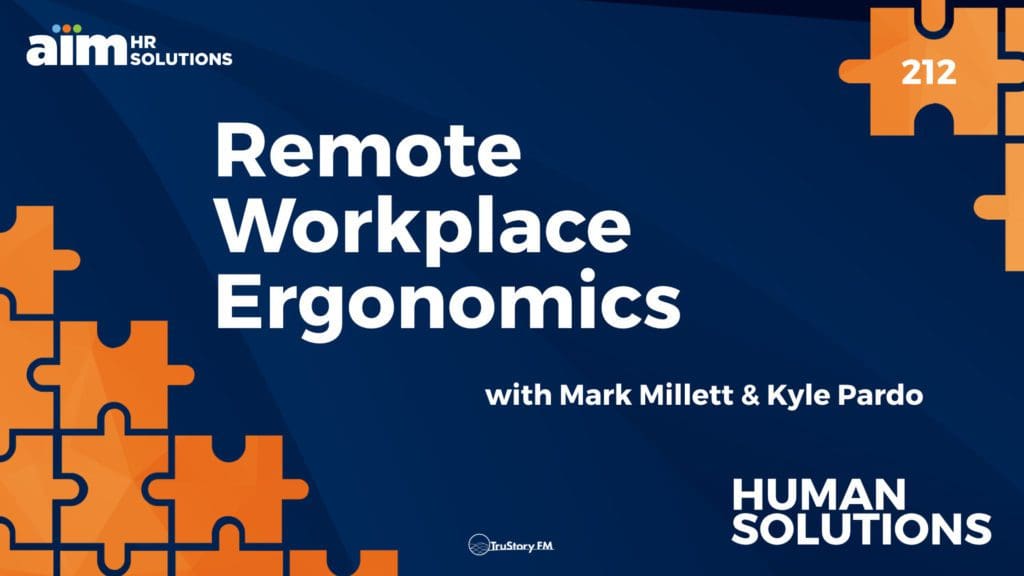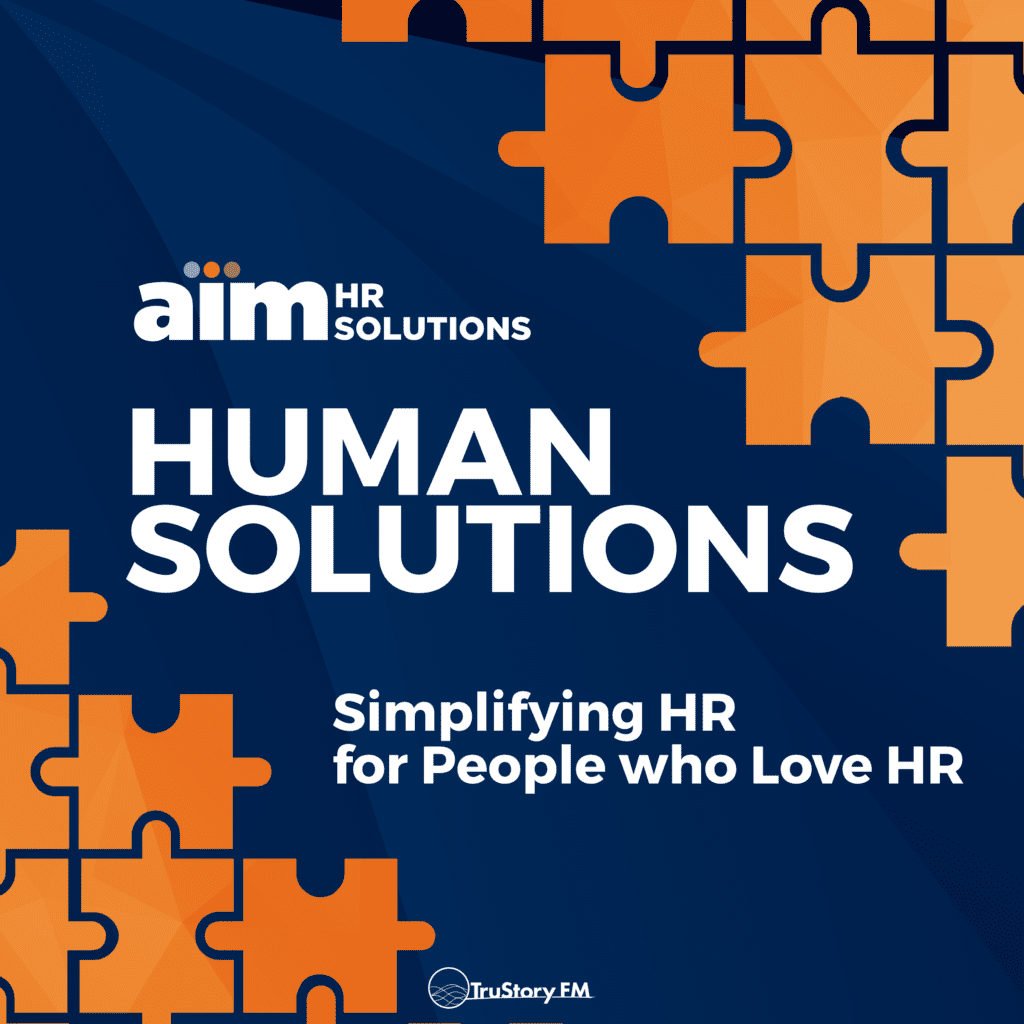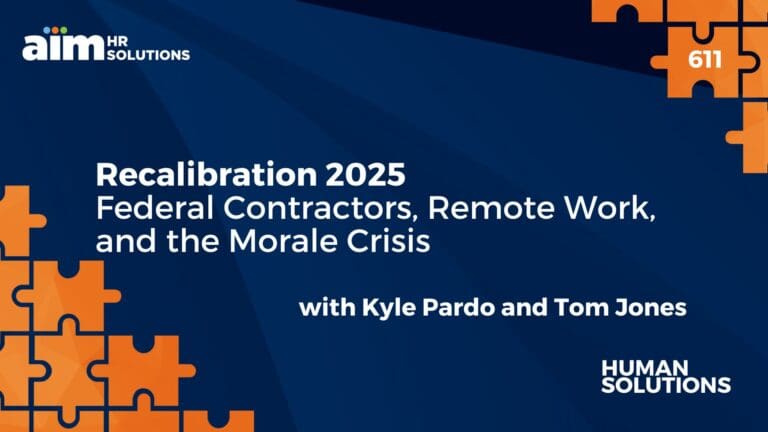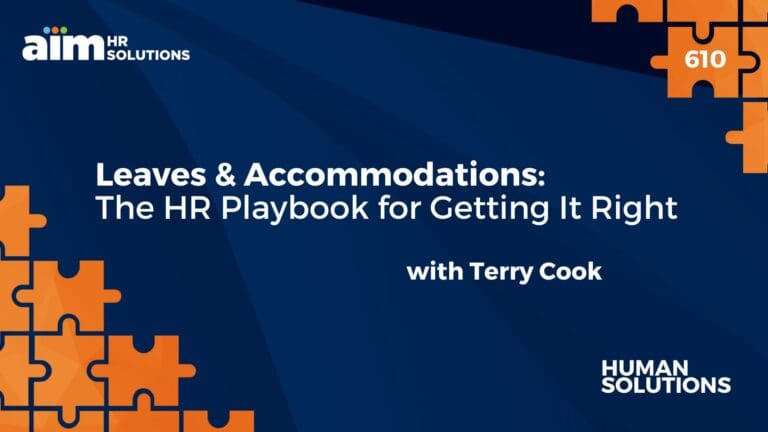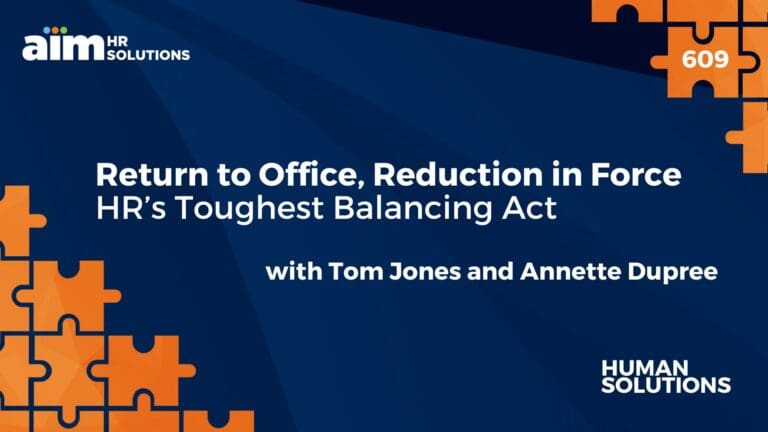The push toward remote work has accellerated considerably since the pandemic’s start. According to the U.S. Census Bureau, the number of people primarily working from tripled between 2019 and 2021. In this episode, Mark Millett, Director of HR from AIM Mutual Insurance Companies, and Kyle Pardo, EVP of AIM HR Solutions, join Pete Wright to uncover how the workplace has transformed post-COVID, and why the ergonomics of your remote workers should be top of mind.
Check out LinkedIn’s Hybrid Office Space.
Episode Transcript
Pete Wright:
Hi, everybody. Welcome to Human Solutions. I’m Pete Wright. The impetus for remote work has shifted considerably since the pandemic’s start. According to the US Census Bureau, the number of people primarily working from home has tripled between 2019 and 2021. In this episode, Mark Millett, Director of HR from A.I.M. Mutual, and Kyle Pardo, EVP of AIM HR Solutions, will uncover how the workplace has transformed post-COVID, and why the ergonomics of your remote workers should be top of mind.
Mark Millet, Kyle Pardo, welcome back to the show. It’s good to have you both here.
Mark Millett:
Thanks, Pete. Happy to be here.
Kyle Pardo:
Great to be here.
Pete Wright:
Mark, you are a first-timer. It’s good to have you on Human Solutions. So glad to be able to tap your expertise today. Before we get started, just to set a foundation for this conversation, what is A.I.M. Mutual and why do you matter to this conversation? How’s that? Is that a fair set-up?
Mark Millett:
That’s a great start. That’s a great start. A.I.M. Mutual Insurance companies, we’re a workers’ compensation insurance carrier. So we provide workers’ compensation to businesses throughout New England to protect their employees in the event of workplace accidents.
Pete Wright:
Very straightforward.
Mark Millett:
Right.
Pete Wright:
And I have to imagine that that function of A.I.M. Mutual has changed fairly dramatically when people are no longer actually working in the workplace.
Mark Millett:
Absolutely. It’s very different, especially from our standpoint. I can tell you pre-pandemic, we had probably about 130 employees in our building. And about 40 were already, it’s interesting, what we called field employees because that was their job, they were out on the road.
And now, to your point about the numbers, that’s kind of almost inverted. Right now we have about 40 or 50, 60 people in the building on any given day, and everyone else is now what we call a remote worker. We’ve actually changed the term from field employee to remote worker, so that’s a big change too. Just the terminology is different.
Pete Wright:
Well, I think I actually just saw a tumbleweed blow by behind you on your Zoom call. It’s very, very different. Kyle, what are you seeing in terms of how organizations are adapting from the perspective of HR during and now post-COVID?
Kyle Pardo:
It’s really, it’s amazing. Remote used to be a rare occurrence, and now we’re seeing with candidates, for sure, that it’s something that people are really asking for in requiring. That they’re not going to take a position if that’s not something that’s a possibility, at least three days a week is really a trend that we’re seeing. So employers are needing to switch to that.
But we’re seeing it with workplaces. Culture’s a little bit different. There are people that you’ve never met in person that you’ve always worked with remotely, and you’ve never interacted in an in-person environment. So it’s changed how managers respond to their employees, it’s changed the physical look of offices, it’s changed the schedule, the employee benefits. So every area,
Mark Millett:
We weren’t even considering remote work before March of 2020. Again, we had our field employees, but other than that, we weren’t even thinking about it. And all of a sudden it can work, it works for us. And now it’s almost, to Kyle’s point, it’s almost the expectation.
Pete Wright:
I read weirdly on Twitter, as I date this episode, this post may not be around for very long, but the CEO of Doist, who, they make workplace communication tools like Todoist and Twist are two of their tools, the CEO was posting how, you know what, remote work, saying that we need people in the office is a myth that we must challenge. That remote work is not only possible, but their example, going on decades of working together as a completely remote organization, they’ve never been together, and it works.
And so I wonder if you could at least test that theory with your experience, that hypothesis with your experience, that having to be, like the synchronicity of water cooler conversations is a functional imperative to work, that we have to be in the same place at the same time. Is it a myth as our CEO has asserted, or is it something that’s working?
Kyle Pardo:
I think it’s a myth. And I’m going to say that because I have worked for AIM since 2006, and I’ve been remote that entire time. So this wasn’t a new experiment. This isn’t only a couple of years in, this is 16 years that I’ve worked remotely. And it works for me. I don’t think it works for everybody. I think there’s some people that really need that in-person touch.
But I found during COVID and with people becoming more comfortable with Teams, with Zoom, I actually see people a lot more now than I did for the first 13 years of a remote engagement where I never saw people in person, or not in person, virtually.
Pete Wright:
Sure.
Kyle Pardo:
So it’s actually gotten more connected, I think, because of Teams and Zoom, from my perspective. But that might be different than other people.
Pete Wright:
Mark, what are you seeing?
Mark Millett:
Yeah, absolutely. I can give you the exact opposite, is I am not a work-from-home person. I come to the office every day because I need that … I’m in HR. I feel like people are here, I should be here. I need that interaction with people. So I prefer the in-person much more.
Having said that, I do agree that it can totally work, remote can … And Kyle’s an example of it, and there’s plenty of companies where that works. What’s interesting is I think companies have to adapt to that. They have to realize that it can work. This notion that, “Oh, it’s just not going to work. There’s no way we can do it.” I don’t think that’s accurate, I think there’s a happy medium.
Pete Wright:
Yeah. I think it’s interesting, Kyle, you bring up Zoom and Teams. I think for a while, as we were returning to life and work with regard to the pandemic, there was a bit of Zoom fatigue. You had people talking about, “Oh, I’m so tired of Zoom.” And yet, I think the adaptation is really interesting that people … I am having more face-to-face conversations than I ever had in my career because the adaptation to video face-to-face is so quick.
And I’m noticing that interestingly with my kids, who are in high school and college, and they default … If they have to talk to someone, the default is always face-to-face. They don’t know why the Phone app exists, it’s video or it’s texts.
Mark Millett:
Right.
Pete Wright:
I think that’s really interesting as you look at those, to your point, Mark, those adaptations. Let’s transition to ergonomics. When you hear the word ergonomics, you think, “Oh, what do I get to make my back feel more straight from IKEA?” What is ergonomics in the case of this conversation?
Mark Millett:
Yeah, so there’s a couple of things. One, especially from our standpoint as a worker’s comp carrier, we want to make sure that people are comfortable, safe, and able to be as productive as possible, no matter where they’re working, whether it’s in the office or remotely.
We do a lot around ergonomics for our policyholders. We do a lot around ergonomics for our employees that want to work remotely. We have everybody that wants to work remote complete an ergonomic assessment. “Here’s where I’m going to be doing my work. Here’s where I’m sitting. Here’s what I’m sitting in.” And if they need one of our Injury Prevention and Worksite Wellness employees to come take a look or get onto Zoom and take a look at their workspace and make recommendations on how they can make that more comfortable and safer, that’s what we’ll do.
Kyle Pardo:
Mark, I’m wondering, just from a practice or policy standpoint, how good are people at getting up and walking around? I always think, you have the ergonomic equipment, you have the great chair, but we have those meetings one after another. And people get tied to their seat and after three or four hours realize, “Oh gosh, I’ve never stood up and stretched my legs today.” Are people, do you find that they’re good about that?
Mark Millett:
I think so. Unless they’re on Zoom and I see them do it, I’m not really sure. But I mean, I’m sitting here in the office and there are days when it’s been three or four hours and I’m like, “Oh, I haven’t gotten up.” So it’s certainly something we talk about. By all means, you have to get up. Even our watches will tell us that we have to get up, time to stand.
Pete Wright:
I was just thinking about that.
Mark Millett:
What we’re you thinking?
Pete Wright:
I went to a conference not long ago, and we’re sitting in a keynote that was two hours long. And at 50 minutes into the keynote you could see people stand up and start kind of stretching their arms in the middle, and walking up and down the aisles a little bit toward the back. And it was all people with their watches telling them that it was time to stand. They’d been sitting for 50 minutes.
Mark Millett:
Time to stand.
Pete Wright:
They needed to make sure they stood up for a minute and get the blood flowing. So I think that’s a really good question, but are these adaptations working well to a subset? I certainly stood up in a case where I normally wouldn’t have.
Mark Millett:
Yep.
Pete Wright:
I saw a video, it was a CBS Sunday Morning I think video, it was not long ago, and it was on LinkedIn’s new hybrid office. They built this new massive thing, and it was under construction for long before COVID, and then it opened during COVID. And what happened when they realized that their entire facility had to change, because they no longer had just cube farms or desk farms, they realized, “We have to be able to accommodate many different styles of working.” Not just to keep people healthy and safe when they’re inside the building, but to, in many cases, become a magnet for people who normally would work at home to come and be comfortable in a way that feels like they have the same flexibility at home.
And they went from having a style of seating in the building, under the original plan, to having more than 75 different types of seating across the facility. You want to sit in a high-back couch that looks like you’re against the wall at a coffee shop, you can do that. You want to sit at a desk with an attached monitor, you can do that. You want to sit at a conference table? Sure. You want to sit in a isolation, sound isolation privacy booth, you can do that. I mean, on and on and on and on and on.
I wonder, Mark, from your perspective, when you hear … I mean, that feels extraordinary to me, 75 different types of seating. Is that the new normal? Is that the future we’re needing to think about from HR professionals when you’re creating the workplace of the future?
Mark Millett:
I agree with you. I think that sounds awful extreme, but I think the concept is right. Why do they have 75 different options? Well, it’s to make sure everybody’s comfortable. I think that’s the important message. You want to make sure everybody’s comfortable and safe, whatever that is.
I’m sure there’s a lot of companies out there that don’t have the resources that LinkedIn has to do that, but whatever you can do. For example, our employees that are at home, if they don’t have a comfortable office chair, we’re going to get them a comfortable office chair. It may not be the $3,000 one that has the fans in the back blowing it. But it’s a safe, comfortable chair. We’ll do that for our employees.
Kyle Pardo:
I think, Pete, to your point too, I think we’ll see office architecture change and home architecture change as a result of the remote work.
Mark Millett:
That’s a great point.
Kyle Pardo:
Offices, because I was recently at a WeWork type of environment where people go to if they don’t have an office, and they had really old-fashioned phone booth looking places that you could go in and just have the small little space for a private conversation. They had the conversation area, so if you didn’t mind other people talking you would choose that area. And then they had the quiet spaces that was like no phone calls allowed in those areas.
And then in the personal space, you think about … The use of the dining room is probably gone, and that’s become a requirement to have a home office or a space that you can close the door from your dog and your kids and the doorbell and all those types of things. It’s really interesting.
Mark Millett:
I saw a real estate posting the other day that literally said, “Living room, dining room, home office.” So yeah, I totally agree with Kyle on that.
Pete Wright:
I wish I had statistics, but just thanks to my rigorous empirical research, I think Tuff Shed is blowing up right now because the number of people, just in our local neighborhood, that are buying attached sheds and long extension cords, the insulated single-purpose, bespoke offices that are in their backyard. Something that they can go into and get away from the sound of the kids running around. And the displacement seems like an artifact of the pandemic, and now we’re professionalizing home work. And that feels like the pendulum is swinging in such a way that it’s going to be hard to see it swing back.
That’s why I like this LinkedIn example, because it’s demonstrating just how hard workplaces are recognizing they have to work to keep people attached to facilities if that’s important to them, if that’s an ideological present.
Mark Millett:
Absolutely. Well, we use this story for those folks that are building their sheds to get away from the kids and the dogs. That’s what we tell our folks, so like, “Do you need a day away from the kids and dogs?”
Pete Wright:
Come to work.
Mark Millett:
“Come on into the office.” Exactly. Exactly.
Pete Wright:
That would be a sales pitch. It’s your work away from home.
Mark Millett:
That’s right. I was just going to say, and we’ve had a lot of that. We’ve had people that haven’t come to the office for two years because of the pandemic and now it’s okay that they come back to the office, and they’re like, “Oh my God, I can do this one day a week. It’s great. It’s good to see people. It’s good to get away from the kids and the dog.” And it seems to work.
Pete Wright:
It feels like it’s introducing a lot more complication in terms of tracking. You just said, “We’re going to buy you a chair at home.”
Mark Millett:
Yep, right. Yep.
Pete Wright:
I assume it extends too far beyond the chair.
Mark Millett:
Correct.
Pete Wright:
Let’s talk about tracking around equipment first. What are you seeing, what are you looking at?
Mark Millett:
During the pandemic, in fact, we wrote a remote workplace policy. And in that policy it says, “If you want to work remotely, we’re going to provide you with this basic equipment. Monitors, keyboards, mouse.” And what’s great is, our IT department is involved in that. And so they track all of the equipment. This person has two monitors. This person has one monitor. This person has an office chair, this person doesn’t.
So we have people that actually … They do, they track all of that. And if an employee is going to be leaving the company, we know ahead of time and we set up ahead of the exit interview, which we might do by Zoom by the way, that we’re going to need to get that equipment back.
Pete Wright:
Okay. The other side of this is tracking … I don’t necessarily want to talk about tracking performance, that’s not really what this is about, but tracking just use of that equipment, tracking activity.
Kyle, this feels like it’s a delicate balance. And I read horror stories of people whose … All this equipment is actually tracking mouse movements, and Amazon’s top seller in office equipment is a mouse jiggler so it makes the mouse seem like it’s still working. What’s your perspective on all of this?
Kyle Pardo:
Any equipment that your employer provides for you is owned by the company. And so they do have the ability to track what websites you’re using, how frequently you’re on your computer, what your activity is, all of that. Whether companies do that or not though, I think, we always say goes back to trust. Are these employees that you can trust and that you can know that they’re getting the work done at the end of the day. And if they go off and they go onto Amazon for 15 minutes, is that impacting the equipment? Is it impacting their productivity? Is it something you need to be concerned about as an employer?
But I do think it’s important for employees to know that it is in the employee’s right to be able to track that because it is in company-owned equipment. So it’s a delicate balance there.
Pete Wright:
There was a trend a while ago, I want to say 15 years ago, but maybe when the iPhone came out, I think that was part of it that drove this. A lot of people, nerds in particular, wanted to use their own phone. So companies had to write BYOD, bring your own device policies. And I know I was a grateful recipient of that policy myself. I was allowed to use a Mac that I have for design work in a Windows organization because I brought my own, and they were okay. I signed an agreement that said, “This is mine.” They couldn’t [inaudible 00:17:55].
Has that shifted in this work-from-home transition? You’re not going to use your own stuff at your own house. We assume we’re going to take care of you.
Mark Millett:
Yeah. We provide every employee that comes through the door their own laptop. If their job requires it, we give them a company cellphone. So definitely. I don’t want to go down a rabbit hole with it, but there’s a whole IT security piece, people using their own device can lead to very compromising situations with malware-
Pete Wright:
Sure.
Mark Millett:
… and all of that stuff. I think that’s part of the conversation too.
Pete Wright:
Yeah.
Kyle Pardo:
It’s also difficult for an IT department to support all sorts of personal devices.
Pete Wright:
Right.
Mark Millett:
Great point.
Kyle Pardo:
So if they know everybody has the same issued computer, that’s much easier for an IT department to support.
Pete Wright:
Right. We certainly have the curse of more choice for personal devices now.
Mark Millett:
Right, right.
Pete Wright:
So how could you even figure that out. Fascinating.
Mark Millett:
And the evolution of technology itself is just, companies are doing that.
Pete Wright:
Yeah.
Mark Millett:
It’s almost cheaper to buy a laptop than a desktop at this point, so companies are doing [inaudible 00:19:07].
Pete Wright:
Well, and that’s actually an interesting point, that maybe that’s the counter to the history of bring your own device, is just make sure that you have a wide variety of devices to choose from for employees. I haven’t heard, for example, the Mac-PC debate in a long time. It used to be, “I’m stuck using Windows. I don’t want to use Windows.” Now, if you come to an employee, I feel like it’s fairly generally accepted that, “Yeah, we can support you and have this recommended device.”
Mark Millett:
[inaudible 00:19:31].
Pete Wright:
Yep, so interesting changes all around.
Kyle Pardo:
I think the only thing is that remote work is here to stay. I don’t think it’s going to go away, I think it’s a … So figuring out how it’s going to work for your company. Obviously it doesn’t work for every position. In hospitality and manufacturing and so many industries that in-person presence is required. But if there’s even an opportunity for it, I think that’s what people are looking for right now.
Mark Millett:
We’re in an office environment and we have positions that remote work just doesn’t lend itself to it, they have to be here. So there is that. But yeah, it’s not going away. And I would tell companies, HR people, that you’re going to have to adapt. You’re going to have to adapt. And I think just, lack of a better term, accept it. It’s here to stay.
Pete Wright:
There you go. Great advice. Sage wisdom, you two. Thank you so much for joining me. Thank you so much as always for being a part of this show. Mark, let’s say somebody’s listening to this, they want to get some more information, some more resources. Do you have a place you can point them?
Mark Millett:
More than welcome to check out our website at www.aimmutual.com. That’s the best place to start. There’s a Contact Us piece on that, so that would be the place to start.
Pete Wright:
Kyle, I’m about to plug your website. You want to send anybody any place else?
Kyle Pardo:
No, absolutely. We work closely with A.I.M. Mutual. They’re great partners of ours. And so I’d encourage people to reach out to either Mark or I directly or to our website. So I’m happy to connect them with additional resources.
Mark Millett:
Absolutely.
Pete Wright:
Outstanding. Well, thank you both and thank you everybody for downloading and listening to this show. We appreciate your time and your attention.
As always, you can find those links and notes at aimhrsolutions.com, or you can just swipe up in your podcast player. All the notes are in there, all the links are right in the notes for this very episode. You can listen to the show on the website or subscribe anywhere you find your favorite podcasts. On behalf of Mark Millett and Kyle Pardo, I’m Pete Wright. We’ll see you next time right here on Human Solutions, simplifying HR for people who love HR.







